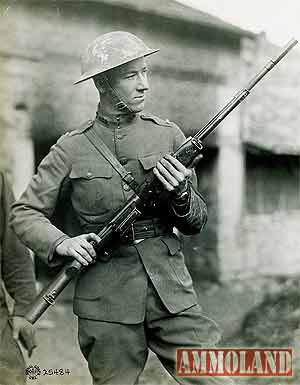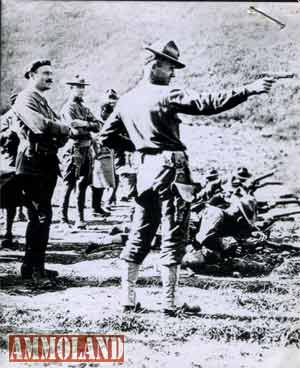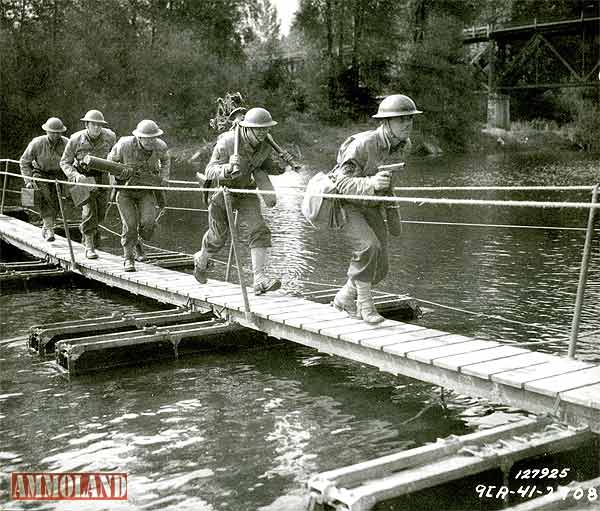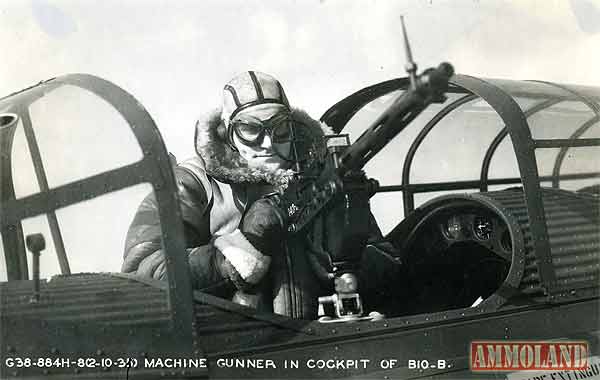The History of the 1911 Pistol

Morgan, UT –-(Ammoland.com)- The Model 1911 .45 Automatic Pistol is the world’s most respected handgun, and has been designated by many authorities as the finest service pistol design of all time.
The Browning 1911 was yet another revolutionary gun by one of the greatest gun designers of all time, John Moses Browning, the founder of today’s Browning Arms Company.
This great legacy is now reflected in the new Browning 1911-22 pistol. Introduced 100 years after the original 1911 pistol, the Browning 1911-22 is proudly made in the USA, at a state-of-the-art factory located only a few miles south of Ogden, Utah – the same town where John M. Browning lived and where the genius of all of his greatest firearms inventions began.
Let’s spend a few minutes exploring the rich history of the original Model 1911 .45 Automatic, and discovering how the world’s greatest handgun came to be.
Any complete history of the Model 1911 must start a decade or more before that legendary year, and half a world away in the Philippines. It was here in the tropical heat of those islands that US Soldiers and Marines found themselves locked in combat with fanatic local insurgents and the immediate need for an effective, large caliber defensive pistol became sorely evident.

In the wake of the sinking of the battleship USS Maine in Havana harbor in February of 1898, the United States went to war with Spain. Along with an invasion of Cuba, US Navy forces engaged, routed and destroyed the Spanish fleet at Manila Bay in March 1898, in one of the most lop-sided victories in naval history. US ground forces then went ashore to overthrow the Spanish colonial government and occupy the islands.
Continuing the armed resistance they had previously shown against the Spanish, the Moro tribesmen of the southern islands (reportedly fueled by a dangerous combination of religious zealotry, ardent tribalism and potent opiates) engaged the American forces in a long bout of guerrilla warfare that ultimately lasted nearly 15 years. Much of the combat was at close quarters, where the Moros’ long-bladed kris knives were used to lethal effect.
At the time US troops were armed with either .30 caliber Krag or Springfield bolt-action rifles and .38 caliber double-action revolvers. While the .30 caliber rifles proved effective in stopping the attackers, the US troop’s handguns demonstrated an unnerving lack of stopping power, resulting in numerous reports of Moro warriors absorbing multiple pistol bullets while they continued to hack away at the Americans. Obviously the US troops’ morale suffered badly in this situation.
The combat pistol situation became so acute that old stocks of Model 1873 Colt revolvers in 45 caliber, many of which dated back to the Plains Indian Wars were returned to active service, where they quickly demonstrated a much better track record of stopping an attacker with one well-placed shot.

The battlefield experience against the Moros resulted in the famous Thompson-LeGarde tests by the US Military in 1904. In these tests a variety of military cartridges of the day were tested for their penetration, ‘stopping ability’ and energy transfer, using both live and dead cattle at the target medium. While somewhat subjective by modern standards, the tests resulted in an official recommendation “…that a bullet, which will have the shock effect and stopping effect at short ranges necessary for a military pistol or revolver, should have a caliber not less than .45.”
About this time two new armament technologies were also emerging – smokeless powder and the autoloading pistol. In 1906 the US Military, under the direction of General William Crozier of the Ordinance Department, began evaluating several pistol designs along with the suitability of a new cartridge that was designated the .45 Automatic Colt Pistol (or .45 ACP for short). As these military tests continued over the next several years, the Colt pistol began to emerge as the clear favorite.
The Colt pistol that was submitted for these military tests was designed by John M. Browning. Without a doubt the most innovative and visionary firearms designer of the late 19th and early 20th centuries, John M. Browning earned the lasting reputation as “The Father of Automatic Fire.” Browning’s design genius was not limited to pistols. Among his other military inventions were the Browning Automatic Rifle (BAR), numerous .30 caliber and .50 caliber Browning machine guns and the legendary Browning Hi Power, the first successful high-capacity autoloading pistol that soon became a worldwide standard for military sidearms.
Based on the short recoil principle of operation, the John M. Browning design for the US Military pistol trials was a magazine fed, single action semi-automatic pistol with both manual and grip safeties that demonstrated a level of durability, simplicity and reliability that no other pistol design of the era could match. In fact, during a 6,000 round test fired over two days in 1910 that was personally supervised by John M. Browning, his sample pistol became so hot that it was simply dunked in a pail of water to cool it for further firing. Browning’s sample reportedly passed the test with no malfunctions.
Since cavalry troops were going to be the primary combat users of the pistol, several specific design features, like the grip safety and lanyard ring, were mandated by the horse soldiers. (Nothing will turn a cavalry trooper into an infantryman faster than shooting his own horse by accident.) The Browning pistol design was formally adopted by the US Army on March 29, 1911, and thus became known officially as the Model 1911. The US Navy and US Marine Corps adopted the Browning-designed pistol in 1913.

The Browning-designed 1911 pistol was first tested in combat in Mexico in 1916. At that time Mexico was wracked by revolution and the most prominent of the rebel generals was Pancho Villa. During the early morning hours of March 9, 1916, Villa and his men attacked, looted and burned the small town of Columbus, New Mexico, resulting in the deaths of 18 US soldiers and civilians. Further attacks by Villa’s rebels in Texas resulted in the deaths of several more US soldiers and officials.
In response to the attacks, President Woodrow Wilson ordered General John J. “Black Jack” Pershing to lead a force of nearly 5,000 US soldiers onto Mexico to capture Villa. Many of the next generation of US military leaders got their first combat experience on this operation, including an ambitious young lieutenant by the name of George S. Patton. While the Punitive Expedition ultimately failed to capture Villa, it did provide the first major combat test of a number of new military technologies such as the airplane, wireless telegraph, motorized truck transport and the M1911 pistol.
The following year marked the entry of the United States into the Great War in Europe. American forces, again under the command of General Pershing, joined with Canadian, French and British troops to push back German forces on the Western Front. In all more than a million US troops served in this worldwide conflict.

WW I, as the Great War soon came to be known, proved a brutal face-off between new weapons and outmoded tactics. Much of the ground combat on the Western Front was conducted as trench warfare, in which small-unit raiding and close quarters combat were common tactics. The Model 1911 proved more than equal to the task, and the powerful pistol quickly became a favorite of American servicemen.
During one legendary engagement Sergeant Alvin York used a Model 1911 pistol to stop an attack by six German soldiers with as many shots, in the process winning the Medal of Honor. Lieutenant Frank Luke of the US Army Air Corps was posthumously awarded the Medal of Honor for his excellent air combat results and his fight to the death with a .45 pistol against a German infantry onslaught after his SPAD biplane was forced down onto a muddy French battlefield.
Other new weapons that emerged from the WW I conflict included tanks, fighter aircraft, rapid-firing artillery, machine guns, poison gas and submarines.
The post-war era saw subtle refinements to the basic Model 1911 design, including the addition of improved sights, an arched mainspring housing, shorter trigger, longer grip safety spur and other ergonomic improvements. Collectively these improvements were completed in 1924 and resulted in the Model 1911A1.
Not long after those modifications were formalized, John M. Browning died of a heart attack at the Fabrique Nationale (FN) factory in Herstal, Belgium, on November 26, 1926.
As the United States began to emerge as a major world military power, the Model 1911 saw combat service in a number of different conflicts, including many small brushfire actions in the Caribbean, South and Central America. These interventions were considered necessary to provide political, social and economic stability to the region and were sometimes called the Banana Wars.
During this era the Model 1911 also became a favorite sidearm of law enforcement officers nationwide, first in .45 ACP and later in the fast-stepping .38 Super. Among the more notable law enforcement users of the 1911 were members of the Texas Rangers, as well as federal agents of the Border Patrol, Prohibition Service and the FBI.
December 7, 1941 brought the Japanese air attack on Pearl Harbor and US entry into WW II. The conflict represented the largest war mobilization in US history, with more than 16 million American men and women serving in the armed forces in every theater of the conflict. The Model 1911 was the standard sidearm for almost all US military forces fighting on the ground, at sea and in the air. Total military production of the Model 1911 was nearly 3 million pistols. Combined with the millions of Browning machine guns and BARs produced over the decades, it is easy to see that the guns designed by John M. Browning played a major role in defending freedom and crushing tyranny. The Model 1911 continued to serve with distinction at the side of American servicemen for most of the remainder of the 20th century including Korea, Viet Nam and other conflicts.

With the end of WW II, millions of US servicemen returned from combat service around globe, eager to enjoy a new life of peace and prosperity. With that post-war prosperity came plenty of leisure time for recreation, and the shooting sports in America literally boomed! Shooting clubs and leagues sprouted up in every city and town, at colleges, high schools, factories and local ranges.
One of the favorite shooting competition formats of the day was NRA Bullseye Pistol, which was modeled on the military pistol qualification courses as taught to millions of GIs. Bullseye pistol required expertise with a .22 rimfire pistol, a centerfire pistol and a .45 pistol, often the Model 1911. Post-war economics also helped build the popularity of the 1911, as it could be used in both the centerfire and .45 phases of competition.
Plenty of Model 1911 pistols were readily available as military surplus or as battlefield trophies brought back by GIs. Pistolsmiths who had learned the gun inside and out in the military began to experiment on how best to turn the 1911 into a target range tack-driver, and their improvements often produced one ragged hole in the target. An entire cadre of suppliers like Pachmayr and Kings Gun Works were soon filling the demand for custom accurized 1911 bullseye pistols.
While formal bullseye competition ruled the roost in the post-war era, another movement was quietly taking shape – a movement that soon came to be known as Practical Shooting. For many decades prior to the 1950s much of the combat firearms training doctrine for law enforcement officers was based on a fast draw followed by unsighted or instinctive one-handed firing from the hip. While this technique may have some application at very close ranges, the hit potential quickly became marginal as distances increased.

One of the first to realize the limitations of hip shooting was a young Marine officer by the name of Jeff Cooper.
He understood that in order to stop an assailant, one had to accurately and rapidly deal him a telling blow before he could complete his attack. Cooper’s WW II combat experience in the Pacific and his visionary thinking lead him to develop what became known worldwide as the Modern Technique.
Drawing upon the wisdom of some of the best pistol shooters of the day, Cooper’s method was to use a smooth one-hand draw moving to a strong two-handed hold, then make a quick eye-level sight alignment on the target and rapidly fire with accuracy.
While the Modern Technique is adaptable to most handguns, the ideal instrument to exploit its full effectiveness is the .45 ACP Model 1911 – a pistol with the power, accuracy and reliability to prevail in a confrontation. Cooper codified the concept of the Modern Technique in the Latin motto Diligentia-Vis-Celeritas (D.V.C.) which translates as Accuracy-Force-Speed.
Cooper’s prolific writings and teaching on the subject, along with those of Charles Askins, Ray Chapman, Jack Weaver, Thell Reed and others helped shape the thinking of an entire generation of law enforcement and military trainers, and today it remains the basis for virtually all training doctrine for combat pistol shooting.
The spread of the Modern Technique was also the major factor in the transition of American law enforcement from the revolver to the autoloading pistol during the 1980s and 1990s.
Cooper also played a major role in the creation of the International Practical Shooting Confederation in 1976 and served as its first president. IPSC created a framework for organized competition and quickly became the competition format of choice for hundreds of thousands of avid pistol shooters. Offshoots of the formalized practical shooting sports have blossomed in recent years, including Cowboy Action Shooting, IDPA, USPSA 3-Gun and many others.
An entire industry based on parts, accessories, custom gunsmithing, training centers and formal competition has grown up around the Model 1911, and today the 1911 design remains the world-wide standard for competition pistols. In fact, the emergence of the Modern Technique, practical shooting and concealed carry have resulted in a virtual rebirth of interest in the 1911 pistol design.
With the growth of practical shooting came a greater awareness of personal security and taking responsibility for one’s own safety. Rising crime rates in the 1980s and 1990s helped spark a broad national movement towards civilian concealed carry licensing.
Today almost every state in the Union offers some form of civilian licensing to carry a concealed firearm, and for many of these millions of CCW licensees the choice is some form of the Model 1911, often in a compact version for easier carry and concealment.
In 1985 the US Military adopted the 9mm M9 pistol as their standard sidearm in hopes of creating greater ammunition interoperability with its NATO allies. Hundreds of thousands of servicemen and servicewomen dutifully turned in their Model 1911 pistols, and no doubt many a tear was shed in memory of the 1911’s seven decades of service.
Alas, the painful combat lessons of the past now came full circle. The marginal stopping ability of the 9mm ball cartridge is no more potent today as when it was first introduced in 1902.
In light of this, the US Military has again turned to the venerable Model 1911 and the .45 ACP to arm their special operations troops.
Two more Medals of Honor were awarded in 1993 to US Delta Force operators, Master Sergeant Gary Gordon and Sergeant First Class Randall Shughart, for their actions in Somalia, which were later immortalized in the book and motion picture “Black Hawk Down.” After Shughart was fatally wounded, Gordon continued his fight to the death using a 1911 to protect one of the wounded helicopter pilots.

Today, when America’s finest go into harm’s way after radical terrorists, chances are a Model 1911 is riding on their hip or MOLLE gear. After 100 years the Model 1911 design is more popular than ever, and remains the standard by which all other autoloading pistols is measured.
We think John M. Browning would like that.
